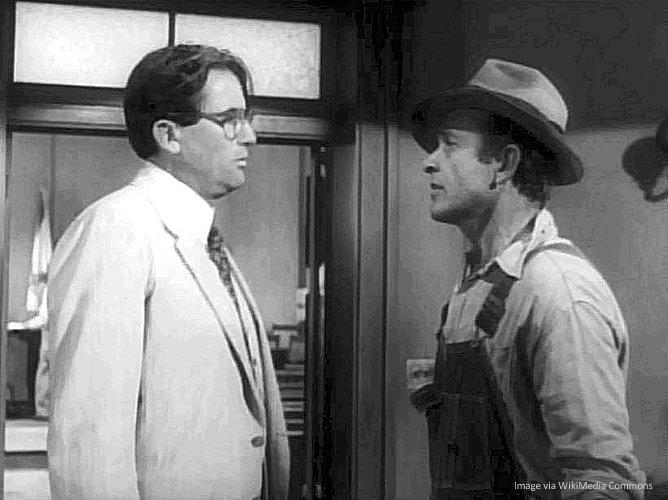
Characters Atticus Finch and Bob Ewell have words in the movie adaptation of “To Kill a Mockingbird.”
By Kendra Hamilton | I enjoyed the Statehouse Report’s discussion of “the elephant in the room” on July 31. But I think a missing element is South Carolina’s legacy of violence against and coercion of … other whites. Two “integration stories” told by friends my age come to mind — stories that helped to shape my thinking, as an African American with deep South Carolina roots, on the dimensions of the problem facing us.
The first, I heard 20 years ago. A bosom friend from Gonzales, La., confided the terror and confusion that descended upon her childhood when she learned that her best friend’s father, a known Klan leader, was believed “by everyone” to have murdered another classmate’s father, a Jew who was active in civil rights. This was in the year that the names Goodman, Schwerner and Cheney screamed from the headlines — but she recalls everyone she knew speaking, if at all, in whispers.
The second I heard last year, while planning the Nat Fuller Feast in Clinton. A Baptist minister on the organizing team — the son of a Baptist minister from rural Georgia — shared the story of waking up one morning and walking out of the door to catch the bus to school … only to see that his house had been vandalized: covered with signs, front and back yards, reading “nigger lover.” He was a popular kid, a football player. His brother was the quarterback. But their father had been preaching against segregation and this public humiliation was the family’s lot.
Who did these people grow up to be? Well, the Baptist minister from Georgia refused to be intimidated, and his son also became a Baptist minister and warrior for civil rights who preaches racial justice here in the heart of a county that practiced lynch law as late as 1937. My girlfriend, meanwhile, found her voice and became a writer, but she remains traumatized, isolated and scapegoated by her family for being “different” and “liberal.”
Why do I repeat these stories? Because I believe whites, in the words of that old song, are not only “carefully taught” to hate, but they are also carefully conditioned to know the consequences if they don’t. The older that one is, the deeper this conditioning runs, and it’s based in part on a well-founded fear of physical harm.
We’re starting to speak openly of the mobs that formed in the 1870s though the 1930s. We’re starting to tell the stories of the African American victims. These are new things, things I didn’t know I’d see in my lifetime. But what we must also acknowledge is that those mobs, their rage and violence, were not just aimed at blacks — the victims included whites as well. Folks who joined the Republican Party, who claimed black kin, or who failed to hide their liking or their loves across the color line, people who were careless, who just didn’t care — these were driven out of the state or defamed, ostracized — disappeared — to create the illusion of a “solid South.”
This, too, is part of the “hidden history” of the South.
As an African American of many generations derivation in South Carolina, there are stories in my family of enslavement and Emancipation, of surviving election riots in the 1870s and ‘90s, of finding the occasional ally, but mostly of out-waiting, outwitting or just enduring the ever-present, ever-implacable hostility of whites. These stories functioned the way the spirituals did, as a psychological armor, helping us to survive and even to thrive with our spirits and souls intact.
But it occurs to me that the taboos surrounding discussions of racial matters in the South — the deeply engrained habits of omission and silence — have left whites not just lacking in command of historical facts or an appropriate vocabulary, they have also left people who profess to be non- or anti-racist without an armor to protect them against a common foe: actual racists.
The “elephant in the room” asks what does the state need to do to move forward. Whites must acknowledge that violence and coercion have been exercised against them, too: an external means of control applied until obedience to the “white code” became internalized, automatic.
This is a form of racial trauma, dealt at the hands of their own people, people, who in many cases, claimed to be acting in the name of love. Whites will be called upon to acknowledge these experiences and to connect them to the discussion that began with #blacklivesmatter, that intensified with the Emanuel Nine, and that encompasses even the outcry over the Atticus Finch of [Harper Lee’s] Go Set a Watchman.
Dr. Kendra Hamilton, daughter of former Charleston County Councilman Lonnie Hamilton III, is a poet and assistant professor of English at Presbyterian College where she is director of the Southern Studies Program.




 We Can Do Better, South Carolina!
We Can Do Better, South Carolina!
























